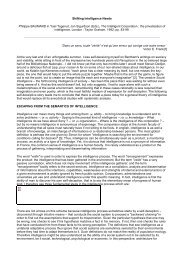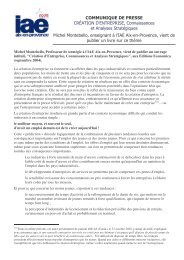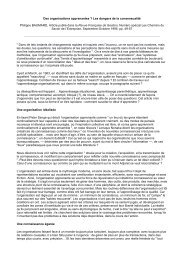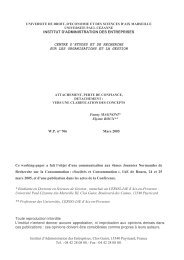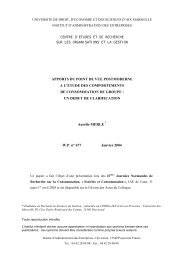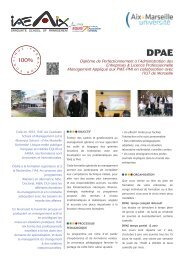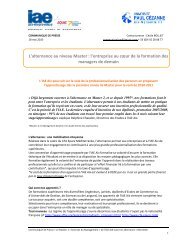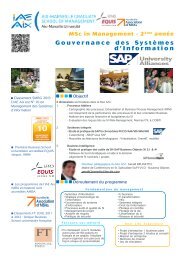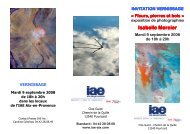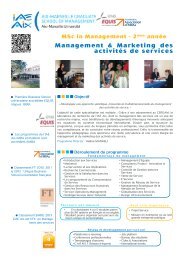Oblique Knowledge: The Clandestine Work of Organizations ...
Oblique Knowledge: The Clandestine Work of Organizations ...
Oblique Knowledge: The Clandestine Work of Organizations ...
You also want an ePaper? Increase the reach of your titles
YUMPU automatically turns print PDFs into web optimized ePapers that Google loves.
Table 1.: Typology <strong>of</strong> knowledge categories<br />
Obliquity<br />
How can we define “obliquity” ? Plato illustrates the concept with an enigma <strong>of</strong> interwining contradictory<br />
interpretations : “A man who was not a man, seeing and not seeing a bird who was not a bird, perched on a<br />
wood that was not a wood, did and didn’t throw a stone that was not a stone” (Plato, 430-347 B.C.). Such was<br />
the puerile riddle <strong>of</strong> the eunuch (“a man who was not a man”), aiming without reaching (“did and didn’t throw”)<br />
because <strong>of</strong> darkness (“seeing and not seeing”) with a pumice-stone (“a stone that was not a stone”) a bat (“a<br />
bird who was not a bird”), perched on a reed (“a wood that was not a wood”).<br />
Plato uses this enigma to enlighten the field <strong>of</strong> opinion — dóxa — where events have double meaning, “where<br />
truth and its contrary interlace tightly” (Detienne, 1967, pp. 114-115). Obliquity is the path that leads us toward<br />
a tolerable solution to Plato’s enigma. Straight rationality fails to provide an answer to such paradox as “a man<br />
who was not a man”, or “a wood that was not a wood.” Only through abductive thinking (Eco, 1992, p. 253)<br />
can we invent a “representation” that would fit the “multiple sensemaking frameworks that are themselves<br />
complex and simple, ambiguous and clear, contradictory and logical, and stable and changing” (Starbuck,<br />
1988) suggested by the ambiguous enigma. Most <strong>of</strong> the famous “deductions” <strong>of</strong> Sir Arthur Conan Doyle’s<br />
Sherlock Holmes are in fact similar creative inductions (Eco, 1992, p. 275) and proceed from obliquity. In <strong>The</strong><br />
sign <strong>of</strong> four (Doyle, 1890), Sherlock Holmes observes traces <strong>of</strong> red mud on Watson’s shoes along with<br />
stamps and a pack <strong>of</strong> postcards on Watson’s desk. He suddenly turns to Watson and asks him why he went<br />
to Wigmore Street that morning to send a telegram. Holmes could not have possibly deducted from the two<br />
available weak signals the proposed solution. He proceeded from oblique knowledge, deriving a sagacious<br />
envision <strong>of</strong> events from abductive construction (ab- signifies the absence or the weakness <strong>of</strong> tangible<br />
evidence or stimuli to derive a formal interpretation: imaginative induction).<br />
Bridging <strong>The</strong> Gap With Managers Today<br />
Our purpose in this paper is to introduce the social scientist to the role and processes <strong>of</strong> oblique knowledge in<br />
organizations today. To achieve this task, we will look at the implicit rules <strong>of</strong> a mode <strong>of</strong> knowledge that, not<br />
surprisingly, disappeared to the advantage <strong>of</strong> metaphysics and rigorous logic. We adopt a double-edge<br />
approach:<br />
• To test the construct <strong>of</strong> metis as practiced in Ancient Greece and unveiled by Detienne and<br />
Vernant: “a type <strong>of</strong> intelligence and thought, a way <strong>of</strong> knowing (that) implies a complex but very<br />
coherent body <strong>of</strong> mental attitudes and intellectual behavior which combine flair, wisdom,<br />
forethought, subtlety <strong>of</strong> mind, (...), resourcefulness, vigilance, opportunism, various skills, and<br />
experience acquired over years (Detienne, Vernant, 1978, p. 3).<br />
• To retain from the above construct the criteria for initiating metis : “It is applied to situations<br />
which are transient, shifting, disconcerting and ambiguous, situations which do not lend<br />
themselves to precise measurement, exact calculation or rigorous logic” (Detienne, Vernant,<br />
1978, p. 4) and to aim at the construction <strong>of</strong> a grounded theory (Glaser, Strauss, 1967) <strong>of</strong><br />
oblique and conjectural knowledge (as a broad definition <strong>of</strong> metis) in organizations today.<br />
We will present three case studies, conducted in 1992 and 1993 in three organizations facing mutability and<br />
unpredictability :<br />
• Indigo Publishing Co., a publisher <strong>of</strong> confidential letters, facing a mutable enigma,<br />
• Banque Indosuez, New York, where we studied the works <strong>of</strong> traders and executive staff facing major<br />
financial loss, internal disputes, and attacks against the French franc, with unpredictable ways out.<br />
• Pechiney, in three different events : facing speculators’ rumors during the financial crisis <strong>of</strong> 1931-1932, trying<br />
to get insights on a technology — the flowing process 3C3 — developed by their competitor (1950s) and<br />
dealing with the decolonization in Guinea (1955-1960), .<br />
Research Question<br />
In these three cases, we will see how “metisitic” processes are used in organizations today, and how they<br />
articulate with other familiar modes <strong>of</strong> representation and action. Detienne and Vernant works (1974, 1978)<br />
unveil both criteria for engagement in “metistic” processes and various descriptions <strong>of</strong> these processes. <strong>The</strong>



